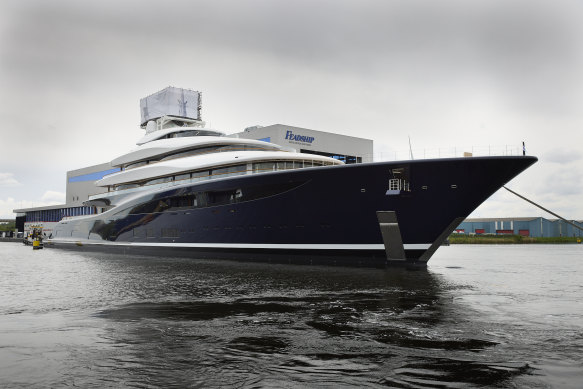
According to analysts at Berenberg, a recent drop-off in sales is “linked to the perception that yachting is significantly exposed to Russian clientele”, such as former Chelsea owner Roman Abramovich.
Meanwhile, a reduction in orders could also indicate that even the wealthiest 0.1 per cent are facing the consequences of economic turmoil.
Project 821, as it is still known, is 119 metres long and 19 metres wide – putting it among the world’s largest pleasure cruisers, such as the 117-metre Koru owned by Amazon founder Jeff Bezos.
However, unlike other superyachts, Gates’ vessel is unique in that it contains a hydrogen power system, including a heavily insulated cryogenic tank containing 92 cubic metres of liquefied hydrogen at minus 253°C.
This is used to generate electricity in a bank of 16 compact fuel cells. The only exhaust from this process is water vapour, signalling Gates’ long-standing interest in alternative fuels.
The software tycoon, who has pledged to give most of his estimated $US129 billion fortune to good causes via the Gates Foundation, has been a leading advocate of decarbonising the energy system in recent years.
His green ambitions have led to him backing a series of clean energy start-ups through his multibillion-dollar fund Breakthrough, although Project 821 appeared more of a personal project for Gates, who was divorced from his wife Melinda in 2022.
According to Feadship, the space required for the hydrogen system added four metres to the yacht’s length.

Project 821, as it is still known, is 119 metres long and 19 metres wide – putting it among the world’s largest pleasure cruisers.Credit: Feadship
Project 821 is not entirely hydrogen-powered, however, and is unable to make a long sea voyage running on green fuel alone.
Instead, hydrogen power can be used to help the yacht make shorter journeys, for instance leaving and entering harbour, travelling at speeds of up to 10 knots, propelled by two electric thruster units.
Feadship says that the vessel’s “hotel load” – the electricity for air conditioning, heating, cooking, lighting etc – can be run for a week on hydrogen only.
For longer journeys, or in the event that supplies of liquid hydrogen are not available, the yacht also has diesel generators with enough power to achieve top speeds of 17 knots.
These can be run on hydrotreated vegetable oil (HVO), described by Feadship as second-generation biofuel – that is, biofuel which is not made from food crops.
Clean energy aside, there is no doubt about the levels of luxury on board the superyacht.
For whoever can stump the cash, the new owner will be given access to an entire deck of their own, 37 metres above the waterline.
Loading
This is arranged as an apartment with two bedrooms, twin bathrooms and dressing rooms, a gym, a pantry, two offices each with a fireplace, and a living room.
Feadship doesn’t specify what type of fuel is burned in the yacht’s fireplaces, but it does go on to say: “The owner accommodation extends beyond a single deck.
“A unique and completely private vertical corridor extends to the lower deck. This includes both a spacious staircase lined with bookshelves and display nooks and an owners’ elevator.
“At each deck level, there are inviting private lifestyle destinations to savour such as a coffee corner and games niche on the bridge deck, a library on the main deck, and a private dining room with a sea terrace and adjacent ensuite stateroom on the lower deck.
“It creates, in essence, a secluded four-level townhouse-by-the-sea within the much larger yacht.”
The yacht also has twelve staterooms for guests, two cabins for members of the owner’s personal staff, accommodation for 44 crew and “a dedicated hospital”.

a recent drop-off in sales is “linked to the perception that yachting is significantly exposed to Russian clientele”, such as former Chelsea owner Roman Abramovich.Credit: AP
Guests aboard will no doubt be impressed by the “towering atrium staircase that wraps around a circular elevator” and the 8.2 metre pool with “contraflow” and two hot tubs, one on the upper sun deck and one in the pool area.
Other features include a spa, swim platform, beach club, library, cinema and a “cosy” underwater “Nemo lounge”.
The yacht has no fewer than 14 retractable balconies.
“The balconies are unnoticeable when closed but slide out at the touch of a button, carrying with them their side railings or walls,” according to Feadship. “When fully deployed, their floors rise to become perfectly level with the interior room.”
The yacht’s partial hydrogen power system is a new departure for the superyacht industry, but hydrogen has already been deployed at scale in the automotive sector.
More than 20,000 Toyota Mirai fuel cell cars have been sold around the world, which store their hydrogen as a high-pressure gas rather than a cryogenic liquid.
Road vehicles with liquefied hydrogen tanks have also been built.
These, like most liquefied gas storage systems, gradually lose their fuel to “boil off” when left parked, an issue which will also affect Project 821.
The process of liquefying the gas is also energy-intensive, meaning hydrogen is not always a low-carbon fuel.
The normal method of manufacturing hydrogen is by making it from natural gas, a process which produces carbon dioxide.
Almost all hydrogen produced today is made using this method, and as such is classed as “grey” hydrogen.
The aspiration is that vessels like Project 821 would be powered by “green” hydrogen, made by using zero-carbon electricity to split water into hydrogen and oxygen.
Alternatively, if the carbon dioxide is captured and stored during the production of hydrogen from gas, it becomes “blue” hydrogen, almost as eco-friendly, though this is not yet done on a wide scale.
Feadship has plans to develop technology which could produce hydrogen from methanol.
Tanks for methanol would be much simpler and would store more energy than liquefied hydrogen alternatives.
These bold proposals are exactly what Gates is pushing for in his bid to save the world from a climate disaster, with or without his £579 million megayacht.
Loading
As he said in an article for The New York Times earlier this year: “Very wealthy individuals should be making changes to their lifestyles to bring their emissions close to zero.
“If you fly in a private jet, as I do, you can afford the extra cost of sustainable aviation fuel made from low-carbon crops and water.
“Wealthy investors have the capital to take risks, and indeed, should be taking more of them.”
The Gates Foundation was contacted for comment.



























